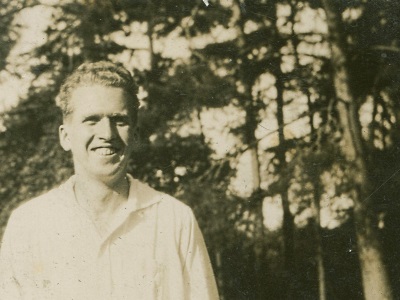This article is the sixth and final in a series on Eberhard Arnold and National Socialism. It follows Emmy Barth’s study, An Embassy Besieged, and page numbers are given in parentheses. The first article can be found here.
Image: The three men who were imprisoned in Germany – Hannes Boller, Karl Keiderling, and Hans Meier – safe in England with their wives and community.
Exiled to England: December 1935–1937
After Eberhard’s death, Emmy and her youngest daughter, Monika, moved to the Alm Bruderhof to be close to the rest of the family still studying in Zürich. Georg and Moni Barth took over the leadership responsibilities at the Rhön Bruderhof. Eberhard had wanted this site to remain active as a witness in Germany, but this was becoming more and more difficult. It was even dangerous for the young men who were in Liechtenstein. Rumour had spread that Germany would soon be extending its conscription roll to those living abroad. As a pre-emptive move, the English members, Arnold and Gladys Mason, began looking for suitable land in the Cotswolds, a largely rural area in southwestern England. They ended up at Ashton Fields near Cirencester and were able to come to an agreement with the landowner. Bruderhof men travelled to England “by various means, mostly illegally” (249). The circumstances were so dire that Heiner Arnold and Annemarie Wächter were married at the Alm Bruderhof and then left for England on the same day.
At first, the new Cotswold Bruderhof attracted a lot of positive attention from the English. (The community would eventually migrate to Paraguay due to English mistrust of a largely German group living among them during the war.) Meanwhile, the Rhön Bruderhof was experiencing leadership difficulties: “Several different men tried over the next months to take on this task, but they failed again and again to provide the needed spiritual and practical leadership” (251). Hans Zumpe wrote to the North American Hutterites, requesting an urgent visit to the Cotswold Bruderhof as the community as a whole, now spread across three different locations, felt themselves deeply in need of direction.
In June 1936, the Gestapo submitted a report recommending the immediate dissolution of the Rhön Bruderhof, referring to the group as “propagandists,” who recruited new members not only from within Germany but from England as well. As such, the continuing operation was “highly detrimental to the interests of Germany.” Where others might have had doubts on the community’s relationship to the state, the report was clear: “The world view taught at the Bruderhof and publicized in Germany and abroad is the very opposite of National Socialism.”1 Barth, observing references to England and Switzerland in the document, suggests that the group had not been dissolved earlier for fear of how the international community would have viewed such an action.
Then, in September, the Bruderhof was informed directly that eligible men would be required to report for military duty. If they fled, other members feared that those remaining would be charged with treason for conspiring in their escape. The men simply wrote back saying that they would be unable to comply with the demand.
On October 7, the Rhön Bruderhof was subject to another raid. While members initially believed this was a response to their refusal to sign up for military service, they later found out that the officials were looking for hidden foreign currency. Laws at the time designed to secure the German economy meant that there were sharp limitations on the amount of foreign currency groups could hold. The Bruderhof’s connections with outsiders, in addition to known donations of foreign currency they had received previously, put them under suspicion. Nonetheless, the raid turned up nothing incriminating.
During this time, the community received much support from friends abroad. The North American Hutterites wrote to the German government, telling of their own refusal serve in the military in WWI and asking that the Bruderhof be exempt from the demand. US Mennonite Harold S. Bender was seeking renewal for the Mennonite church. He was deeply impressed and inspired by the Bruderhof witness, as well as being taken by their situation. Bender wrote to the German embassy in Washington to advocate for their safety. German Mennonite Michael Horsch was alerted to the Bruderhof’s situation by a brother in the US. He sent 300 marks for food and also attempted to arrange for weekly support payments for the community, but the latter proposal was rejected by other Mennonites. Unfortunately, just a few months later, Horsch made a complete about-face in his relationship to the community and produced an article on them that, among other things, alleged agricultural and financial mismanagement. His account is disputed by Barth, among others, as the product of potential Gestapo propaganda.2
Meanwhile, governmental pressure was mounting. At the end of November 1936, an outstanding amount of 15,000 marks was demanded for a mortgage given to the community by the Weimar government in 1928. “This serious financial blow was surely intended to bankrupt the Bruderhof” (264). The Cotswold Bruderhof managed to raise the funds, but because those in Germany couldn’t accept foreign donations, the Rhön Bruderhof “sold” the printing press to them. Yet the payment did little to exhaust the authorities’ interest in expelling the community.
By 1937 it had become clear that the Rhön Bruderhof was reaching the end of its days. Members shipped furniture and books to England and sold their livestock. Karl Keiderling recalls in his memoirs:
Strangers now began to appear and walked around our property as if they were the masters. Cattle dealers, boys from villages, persons came whom we had never seen before. They brazenly opened the door of the barn or went into the stable to look at the horses. They offered ridiculously low prices for our wagons, plows, machinery, or cattle. When we were not there, they smeared the walls with dirt and drew swastikas on the walls and doors of our stables. Building material left on the hill near the burial ground was stolen. Someone tried to set fire to the nursery of pines.
We hadn’t a single friend anymore. Friends and acquaintances of former years had withdrawn from us out of fear of the authorities. Dealers from whom we had bought for years now refused us credit lest they be suspected of supporting the Bruderhof.
As rumors got around that we were leaving, our creditors made urgent demands on us. Not a day went by without two, three, or four of our creditors coming to the office. Each day the mail brought bills, demands for payment, threats of legal proceedings, and notices of recourse to the bailiff.3
While it remains true that virtually everyone outside the community in Germany had given up on them, the group still retained its connections to the North American Hutterites. The Cotswold Bruderhof received two Hutterite ministers on February 7, which was deeply encouraging for the community. After two months in England, the ministers travelled to the Rhön Bruderhof, arriving there on April 9. They were able to offer them much-needed spiritual direction and comfort, though their arrival proved providential for other reasons too.
In early March, the Gestapo had recommended the dissolution of the Rhön Bruderhof. These plans came to a head on April 14, when perhaps fifteen to twenty policemen and around fifty SS men arrived on the property at 10:00 am. Everyone was herded into the dining room and told that they would have to leave the premises within 24 hours because the Rhön Bruderhof had been dissolved. Books, documents, and personal items were confiscated, and the group was informed that they no longer owned any of the communal property. The community was also told that German men of military age would be required to register for service – but this decision was revoked the next day. The two ministers remained with the community during this time, their presence perhaps ensuring that nothing more sinister transpired.
The majority of the Rhön Bruderhof members eventually arrived in either Liechtenstein on April 17 or in England in mid-June. But three men were kept in jail on trumped up charges of “valuating the property too high and of deceiving and swindling their creditors,” accusations that “would clear the Nazis of being accused of persecuting Christians” (278). Hella Römer was also made to stay at the Rhön Bruderhof as a bookkeeper for another month, “in effect under house arrest” (278). With the help of friends, Quakers, relatives, the Bruderhof lawyer Dr. Eisenberg, and ultimately Frank Gheel van Gildemeester, a man with a history of freeing people imprisoned on political grounds, the men were released on June 26 and arrived in England within a week. For this period at least, the Bruderhof in Germany had come to an end.
Barth concludes: “The Rhön Bruderhof was auctioned on September 29, 1937. After the war, the Bruderhof filed a claim for restitution with the German government. The proceedings dragged on for several years, but the community was eventually able to collect compensation for the land, inventory, and many individual personal claims” (289).
Series index:
1. Overview and Literature
2. The Bruderhof under Nazi Rule: January–September 1933
3. Nazi Interest in the Bruderhof: October–December 1933
4. The Establishment of the Alm Bruderhof: 1934
5. Escape from Germany: 1935
6. Exiled to England: December 1935–1937
1. Berlin, Bundesarchiv, Abteilung Deutsches Reich (BArch R 5101/23410 [fol. 133–38]), cited in Barth, Embassy Besieged, 254–56.
2. See Thomas Nauerth’s careful and detailed work, “Michael Horsch and the Rhön Bruderhof, 1936-1937: From Friend to Hostile Witness to Historical Eyewitness,” Mennonite Quarterly Review 91 (2017): 213–46. Nauerth wryly observes, “If we accept his [Horsch’s] version of what happened, then we must be prepared to believe that the Gestapo and the SS's intelligence agency raided a Christian community purely in order to ensure that the fields and pastures are properly cultivated and that no creditors come to harm” (239, slightly adjusted). Grandson of Michael Horsch, Volker Horsch, provides an important reply to Nauerth that calls into question his framing of the relationship between the Mennonite and the Bruderhof. An abridged translation is published in English as “Michael Horsch: A Victim of His Nationalist Sympathies? A Response to Thomas Nauerth,” Mennonite Quarterly Review 92 (2018): 299–305.
3. Karl Keiderling, unpublished memoirs, cited in Barth, Embassy Besieged, 269–70.


